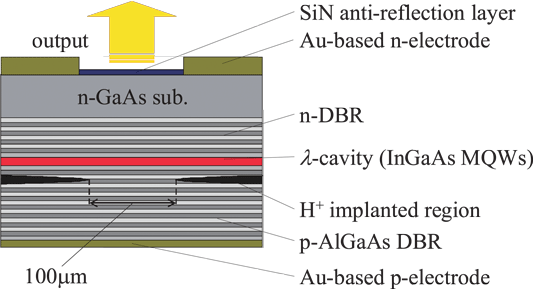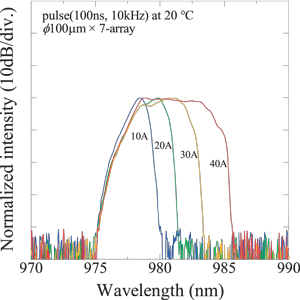Hamamatsu reports record-power-density VCSEL
Hamamatsu Photonics K.K.has reported the first demonstration of 10-watt-class output power for a vertical-cavity surface-emitting laser(VCSEL)array with ion-implanted isolated current apertures[Hideyuki Naito et al,Appl.Phys.Express,vol5,p082104,2012].The power density was three times the record for short-pulse-operated oxide-confined VCSELs.
Selective oxidation and ion implantation are typical current-aperture technologies for VCSELs.For high efficiency these apertures must be of high quality.Although oxidation is the most common technique in production,ion implantation has the potential to be the better technique for large-aperture devices.Disadvantages of oxidation include the introduction of strain and defects that degrade performance.An advantage of oxidation is that it provides transverse optical confinement to reduce diffractive losses–a feature that is not as important at larger apertures.
The epitaxial structure for the VCSEL(Figure 1)was grown on n-type gallium arsenide(n-GaAs)substrate using metal-organic vapor phase epitaxy(MOVPE).The distributed Bragg reflector(DBR)structures were constructed from layers of different aluminium gallium arsenide(AlGaAs)alloys.The multi-quantum well(MQW)light-emitting active region consisted of indium gallium arsenide(InGaAs)in a wavelength cavity(λ-cavity).The designed emission wavelength was 980nm.The 100μm-diameter current aperture was defined using proton(H+)implantation.The light-emitting aperture was covered with an anti-reflection coating.Seven devices were put in a hexagonal array with spacing of 150μm.

Figure 1:A schematic cross-sectional structure of a bottom-emitting proton-implanted VCSEL.
In pulse mode(100ns,10kHz repetition)the peak output power was 40.6W(a density of
73.8kW/cm2)at an injection current of 50A(90.9kA/cm2).The pulse conditions are typical for sensing and ranging applications.The new device compares with the maximum power density of oxide-confined VCSELs of 24.6kW/cm2 with a pulse width of 60ns and 100Hz repetition.
The researchers comment:"In spite of a harder drive condition in our study,the output power-density of our device is three times greater than that of the device described in the previous report".
 The spectral width of the output increases with current.It is thought that this is related to transient spectral shifting effects of the pulse-mode operation.In previous work,the researchers found the spectral width of a similar device operated in continuous-wave(CW)mode had a spectral width around 0.4nm.This compares with a width of the order of 10nm for a 40A pulsed current(Figure 2).It is estimated from the spectral broadening that the device temperature during a pulse increases around 70K,in line with the rise of 60–80K at which output power saturation occurs in a single device under CW operation.
The spectral width of the output increases with current.It is thought that this is related to transient spectral shifting effects of the pulse-mode operation.In previous work,the researchers found the spectral width of a similar device operated in continuous-wave(CW)mode had a spectral width around 0.4nm.This compares with a width of the order of 10nm for a 40A pulsed current(Figure 2).It is estimated from the spectral broadening that the device temperature during a pulse increases around 70K,in line with the rise of 60–80K at which output power saturation occurs in a single device under CW operation.
Figure 2:Time-averaged spectra of the seven-array under 100ns-pulse operation.
"It is thought that the output power is suppressed at the last part of the pulse duration,although the peak output power is not saturated,"the researchers comment.
Closer study of the power output with time around the pulse showed a faster fall of the transient peak at higher injection current.Therefore,although no significant output power saturation was seen in measurements up to 50A(the limit of the measuring equipment),the researchers expect deviations from linear behavior to occur above 50A.
"In order to achieve a higher output power,it is essential to apply effective thermal management and to reduce the electrical resistance in DBRs for less heat generation,"the team comments.





